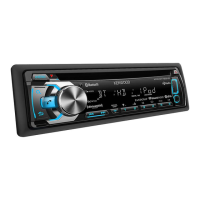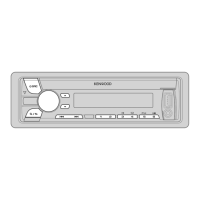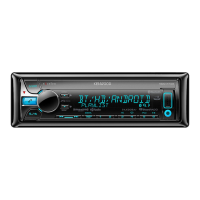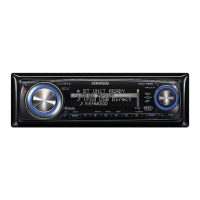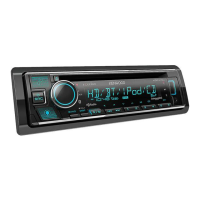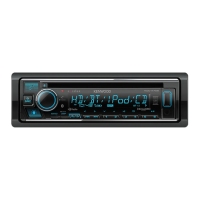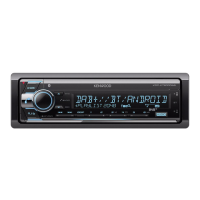Do you have a question about the Kenwood KDC-X790 and is the answer not in the manual?
Safety advice for usage and preventing damage to the unit and user.
Guidelines for panel attachment, CD loading, and lens fogging.
Information on connecting compatible external CD players.
Instructions for cleaning the unit's faceplate and its terminals.
Steps to perform before using the unit for the first time.
Details on optional DAB tuner control and PC software.
Regulatory notice regarding radio frequency energy emissions.
Guidelines for handling CDs to prevent damage and ensure proper playback.
Lists discs incompatible with the unit, including damaged or non-standard discs.
Recommendations for storing CDs to protect them from damage.
Details on supported AAC, MP3, and WMA file formats and their specifications.
Constraints on file/folder names, structure, and character limits.
How audio files are played, including options for sequence numbering.
Explanation of the system's purpose and one-button multi-function capability.
How to configure and view functions assigned to buttons.
Demonstrates how to use the multi-function key system with an example.
Basic operations for turning the unit on/off and selecting audio sources.
Adjusting audio volume levels and using the attenuator function.
Choosing predefined sound settings for different music types.
How to enter and use the System Q sound adjustment mode.
Adjusting bass, treble, balance, and fader settings.
Steps to enter and adjust basic audio settings.
Fine-tuning bass, middle, and treble frequencies.
Configuring sound system parameters like crossover networks and EQ.
Managing audio zones and optimizing sound based on speaker type.
Controls for subwoofer output, call muting, and faceplate angle adjustment.
Removing and reattaching the detachable faceplate for security.
Changing the display mode and layout options.
Switching between different graphic display modes for visual customization.
Specific graphic options available for Display Types A and B.
Choosing background images for the display when using specific types.
Configuring text information displayed on the unit for Type B.
Customizing text content for different display parts like upper, middle, lower.
Lists information sources available for text display on the unit.
Customizing content for the middle text display area.
Customizing content for the lower text display area.
Adjusting text color for different display modes.
Specifics on setting font colors for various display types.
Alternating between different G-Analyzer graphical displays.
Prerequisites for using G-Analyzer displays, including calibration.
Procedures for titling stations or discs for easy identification.
Details on entering and operating the naming mode.
How to select radio stations using manual or preset tuning.
Different methods for tuning stations, including auto seek and preset seek.
Accessing stations by direct frequency entry.
Saving and recalling favorite stations using preset buttons.
Automatically storing strongest stations in memory.
Recalling stored stations using preset buttons.
Scrolling displayed text information from radio stations.
Searching for stations by program type.
Assigning Program Types to stations for easier searching.
Saving and recalling Program Types to preset buttons.
How to play CDs and audio files, including pause and play functions.
Procedures for inserting and removing discs from the unit.
Operating connected external disc changers.
Locating specific discs, folders, tracks, or files.
Replaying selected content (track, file, disc, folder).
Previewing tracks or files to find desired audio.
Playing songs in a random order on the disc or within a folder.
Specific random play modes for audio files and disc changers.
Navigating and selecting folders on media for playback.
Changing playback categories for ACDrive discs.
Searching songs by initial letter of genre, artist, or album name.
Scrolling text information on the CD text, audio file text, or MD title.
Activating the SIRIUS tuner source for satellite radio reception.
Adjusting tuning modes and selecting SIRIUS channels.
Finding SIRIUS channels by category or direct number entry.
Managing preset SIRIUS channels across different bands.
Accessing saved SIRIUS channels from memory.
Scanning for channels and scrolling text information.
Overview of the HD Radio tuner features and functionality.
Selecting HD Radio bands and stations.
How to access and move through menu options.
Adjusting various settings via the menu system.
Setting a code to prevent unauthorized use of the audio unit.
Removing the security code to disable the protection feature.
Enabling or disabling operation check sounds (beep sound).
Setting the clock and date manually.
Syncing clock with RDS data and controlling display brightness/off.
DSI, illumination color, dimmer, and built-in amplifier settings.
Adjusting G-Counter sensitivity for different vehicles.
Resetting G-Analyzer data and performing calibration.
Selecting vehicle type for horsepower measurement.
Entering vehicle weight for accurate horsepower measurement.
Measuring and displaying vehicle horsepower and max power.
Selecting custom graphics for the G-Analyzer display.
Starting, stopping, and resetting the stopwatch function.
Configuring front/rear channel audio output for dual zone.
Restoring high frequencies for low bit rate audio files.
Adjusting bass levels and controlling connected AMPs.
Managing traffic broadcasts and FM reception quality.
Setting HD Radio modes and viewing SIRIUS ID.
Customizing display options for auxiliary input sources.
Forcing playback of problematic CDs.
Procedures for downloading movies, wallpapers, and G-Graphics.
Constraints and troubleshooting for picture downloads.
Announcements during playback and firmware version display.
Displaying serial number and saving audio settings.
Loading previously saved audio configurations.
Enabling or disabling the product demonstration mode.
How to load and replace batteries in the remote control.
Explanation of key buttons like VOL, SRC, ATT, and others.
Remote functions for audio settings and dual zone system.
Buttons for radio and disc playback/navigation.
Buttons for operating the SIRIUS tuner.
Buttons for operating the HD Radio tuner.
List and diagrams of supplied accessories for installation.
Step-by-step guide for installing the unit in the vehicle.
Diagram and description of the main wiring harness connections.
Detailed diagram of all wire-to-terminal connections.
Mounting instructions for specific non-Japanese car models.
Mounting instructions for specific Japanese car models.
Instructions for securely attaching the faceplate to the main unit.
Steps to detach the protective rubber frame from the unit.
Step-by-step guide to detach the main unit from the dash.
Solutions for common power, source, and sound issues.
Problems with radio reception, tuning, and traffic information.
Problems with CD playback and disc handling.
Problems with MP3, WMA, AAC file playback and display.
Problems with HD Radio reception and sound quality.
Explanations for common error messages and operating conditions.
Technical details for radio reception and disc playback.
Output power, dimensions, operating voltage, and other general specifications.
Instructions to disable the product demonstration mode.
Information about the card needed for panel replacement due to theft or damage.
Details on what is covered by the warranty and for how long.
Instructions for seeking service under warranty, including contact information.
| DIN Size | Single DIN |
|---|---|
| Preamp RCA Outputs | 3 Pairs |
| Subwoofer Preamp RCA Output | Yes |
| Preamp Voltage | 4 Volts |
| Display Type | LCD |
| Button Color | Variable Color |
| CD Signal-to-Noise | 105 dB |
| CEA-2006 Compliant | Yes |
| MP3 Playback | Yes |
| WMA Playback | Yes |
| AAC Playback | Yes |
| ID3 Tag Display | Yes |
| AM/FM Tuner | Yes |
| FM Presets | 18 |
| AM Presets | 6 |
| Radio Data System (RDS) | Yes |
| Bluetooth Compatibility | Yes |
| USB Input | Yes |
| AUX Input | Yes |
| iPod Connection | Yes |
| Android Compatibility | Yes |
| HD Radio | No |
| Satellite Radio Ready | Yes |
| Steering Wheel Control Compatible | Yes |
| High-Pass Filter | Yes |
| Low-Pass Filter | Yes |
| Subwoofer Level Control | Yes |
| Time Alignment | Yes |
| Faceplate Security | Detachable |
| Max Power Output | 50 watts x 4 channels |
| RMS Power Output | 22W x 4 |
| Display Color | Variable |
| Bluetooth Profiles Supported | A2DP, AVRCP |
| Equalizer | 13-Band Graphic EQ |
| Dimensions (W x H x D) | 7 x 2 x 6.2 inches |
| Preamp Outputs | 3 |
